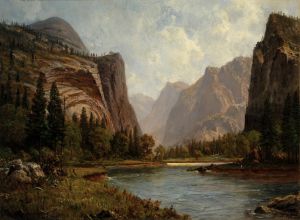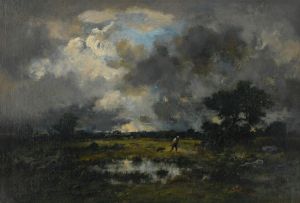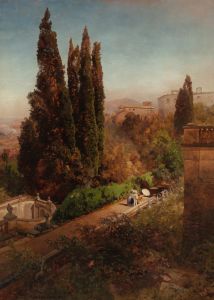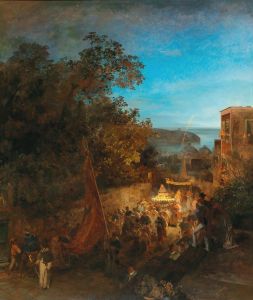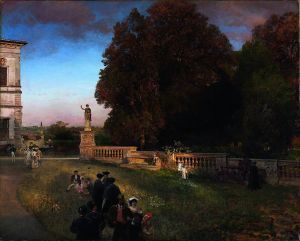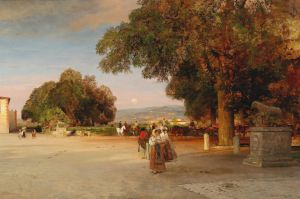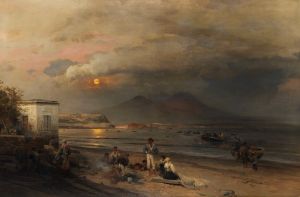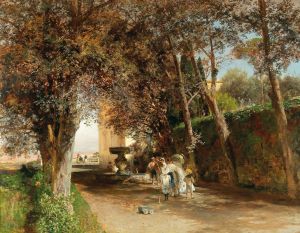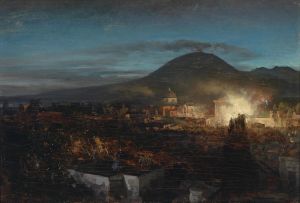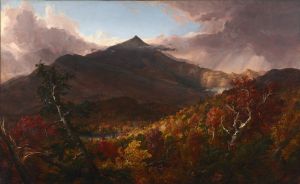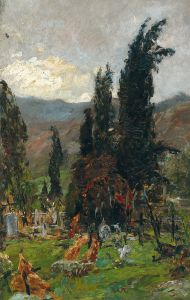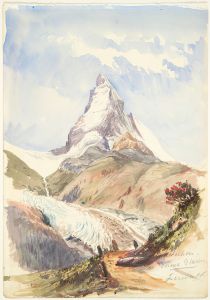
Campo Santo in Poggioreale, the Vesuvius Beyond
A hand-painted replica of Oswald Achenbach’s masterpiece Campo Santo in Poggioreale, the Vesuvius Beyond, meticulously crafted by professional artists to capture the true essence of the original. Each piece is created with museum-quality canvas and rare mineral pigments, carefully painted by experienced artists with delicate brushstrokes and rich, layered colors to perfectly recreate the texture of the original artwork. Unlike machine-printed reproductions, this hand-painted version brings the painting to life, infused with the artist’s emotions and skill in every stroke. Whether for personal collection or home decoration, it instantly elevates the artistic atmosphere of any space.
Oswald Achenbach, a prominent German landscape painter of the 19th century, is renowned for his vivid and atmospheric depictions of Italian landscapes. One of his notable works is "Campo Santo in Poggioreale, the Vesuvius Beyond," which exemplifies his masterful use of light and color to capture the essence of the Italian countryside.
Achenbach was born on February 2, 1827, in Düsseldorf, Germany, and became a leading figure in the Düsseldorf School of painting. This school was known for its detailed and realistic portrayals of landscapes and historical scenes. Achenbach's work often focused on the Italian landscape, a subject that fascinated many artists of his time due to its rich history and dramatic scenery.
"Campo Santo in Poggioreale, the Vesuvius Beyond" is a painting that reflects Achenbach's deep appreciation for Italy's natural beauty and historical significance. The painting depicts the Campo Santo, a cemetery located in Poggioreale, Naples, with the imposing silhouette of Mount Vesuvius in the background. This composition highlights Achenbach's skill in balancing the serene and the sublime, a hallmark of his landscape paintings.
The painting captures the tranquil atmosphere of the cemetery, with its orderly rows of tombs and lush greenery, set against the dramatic backdrop of Vesuvius. Achenbach's use of light is particularly noteworthy; he employs a warm, golden hue to bathe the scene, suggesting either the glow of dawn or the soft light of dusk. This choice of lighting not only enhances the mood of the painting but also emphasizes the contrast between the peaceful foreground and the looming presence of the volcano.
Achenbach's attention to detail is evident in the meticulous rendering of the cemetery's architecture and the natural landscape. The trees and foliage are depicted with a delicate touch, while the distant Vesuvius is painted with broad, sweeping strokes that convey its grandeur and power. This juxtaposition of detailed foreground and expansive background is a technique Achenbach frequently used to draw viewers into his landscapes, inviting them to explore both the immediate and the distant elements of the scene.
Throughout his career, Achenbach traveled extensively in Italy, drawing inspiration from its diverse landscapes and rich cultural heritage. His Italian scenes, including "Campo Santo in Poggioreale, the Vesuvius Beyond," were highly regarded for their authenticity and emotional depth. Achenbach's ability to capture the spirit of a place made his works popular among art collectors and critics alike.
Oswald Achenbach passed away on February 1, 1905, in Düsseldorf, leaving behind a legacy of remarkable landscape paintings that continue to be celebrated for their beauty and technical mastery. "Campo Santo in Poggioreale, the Vesuvius Beyond" remains a testament to his skill as a landscape artist and his enduring fascination with the Italian landscape.





